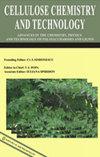热致变色胶印中溶剂滞回对热致变色效果的影响
IF 1.1
4区 农林科学
Q2 MATERIALS SCIENCE, PAPER & WOOD
Cellulose Chemistry and Technology
Pub Date : 2023-09-29
DOI:10.35812/cellulosechemtechnol.2023.57.74
引用次数: 0
摘要
“在四种不同的纸张基材上测定了三种热致变色胶印油墨的印刷品的比色值——粗大的、合成的、过滤的(纯纤维素)和在一个加热-冷却循环中回收的。”冷却后的打印比在相同温度下加热的打印要轻。这种现象是由于微胶囊内部或外部溶剂的滞后性造成的。溶剂的凝固温度低于溶剂的熔点。由于溶剂的滞后性,在相同温度下,当打印件冷却时,固体聚合态的溶剂浓度低于加热时。因此,液体溶剂阻止了染料和显影剂的相互作用和它们的彩色复合物的形成,即显色,并且印刷品颜色较浅,即颜色较少。因此,比色冷却曲线相对于加热比色曲线向左移动。对于某些纸基材,例如,当印刷纸非常可压缩时,就像在大块纸的情况下,许多微胶囊的变形是如此之大,以至于它们在显色方面完全不起作用。”本文章由计算机程序翻译,如有差异,请以英文原文为准。
INFLUENCE OF SOLVENT HYSTERESIS IN THERMOCHROMIC OFFSET PRINTS ON THE THERMOCHROMISM EFFECT
"The colorimetric values of prints of three thermochromic offset inks on four different paper substrates – bulky, synthetic, filter (neat cellulose) and recycled in one heating-cooling cycle – were determined. Prints that are cooled are lighter than those that are heated at the same temperature. This phenomenon is a consequence of the hysteresis of the solvent inside or outside the microcapsules. The solidification temperature of the solvent is lower than the melting point of the solvent. Due to solvent hysteresis, the concentration of solvent in the solid aggregate state at the same temperature is lower when the prints are cooled than when they are heated. Therefore, the liquid solvent prevents the interaction of dyes and developers and the formation of their colored complex, i.e. color development, and the prints are lighter, i.e. less colored. The colorimetric cooling curves are therefore shifted to the left relative to the heating colorimetric curves. As regards certain paper substrates, for example, when the printing paper is very compressible, as in the case of bulky paper, the deformations of many microcapsules are so great that they become completely inactive in terms of color development."
求助全文
通过发布文献求助,成功后即可免费获取论文全文。
去求助
来源期刊

Cellulose Chemistry and Technology
工程技术-材料科学:纸与木材
CiteScore
2.30
自引率
23.10%
发文量
81
审稿时长
7.3 months
期刊介绍:
Cellulose Chemistry and Technology covers the study and exploitation of the industrial applications of carbohydrate polymers in areas such as food, textiles, paper, wood, adhesives, pharmaceuticals, oil field applications and industrial chemistry.
Topics include:
• studies of structure and properties
• biological and industrial development
• analytical methods
• chemical and microbiological modifications
• interactions with other materials
 求助内容:
求助内容: 应助结果提醒方式:
应助结果提醒方式:


